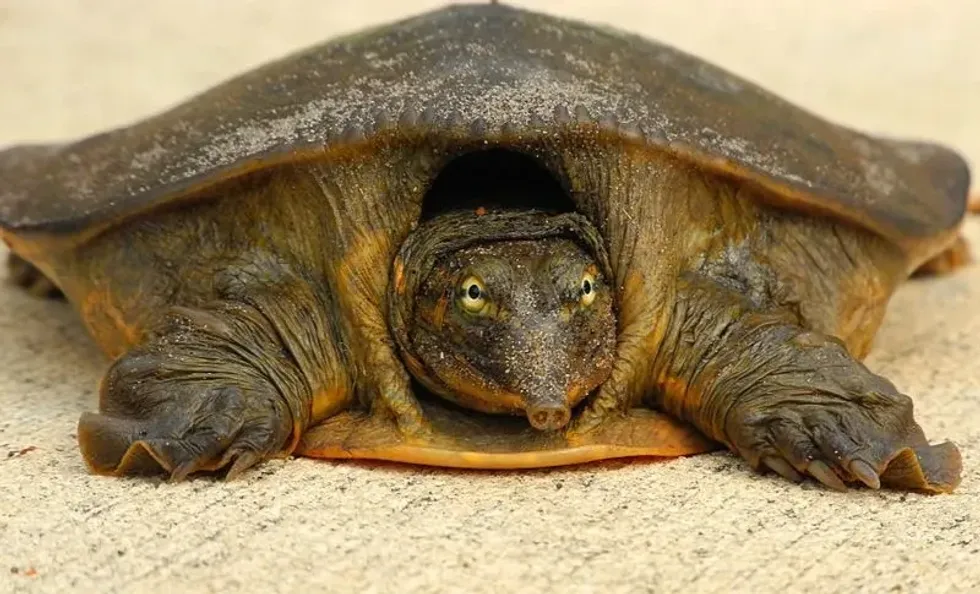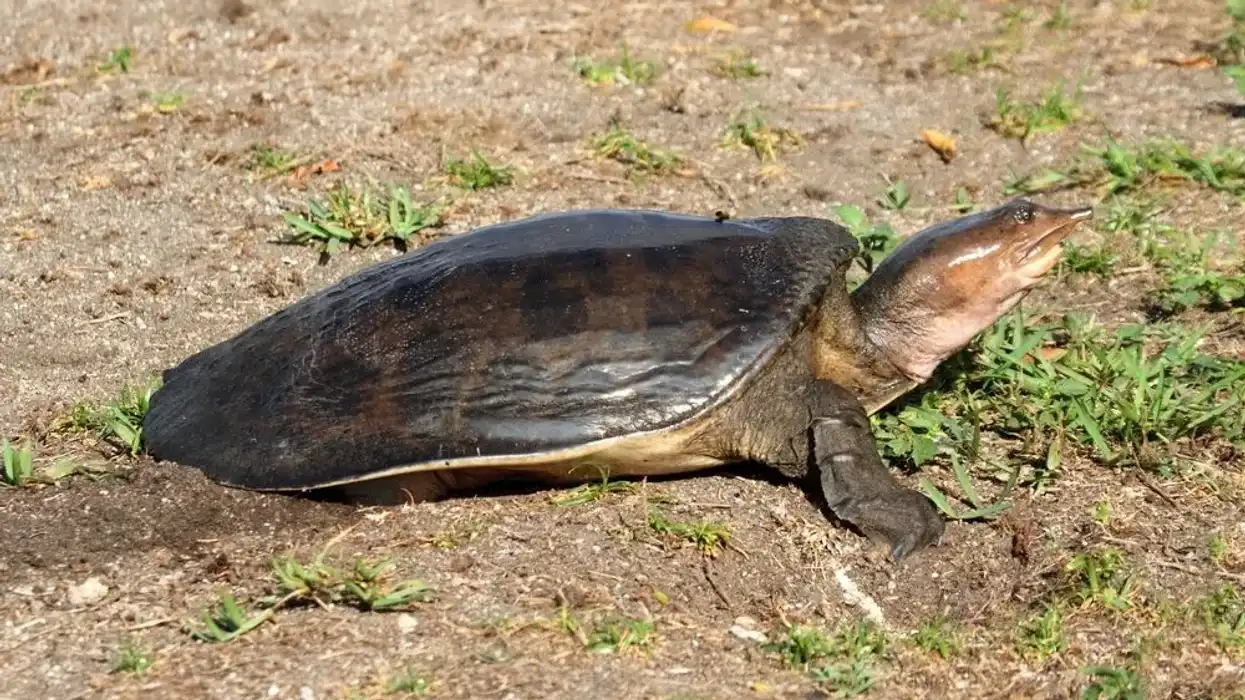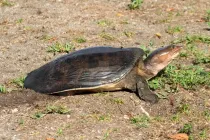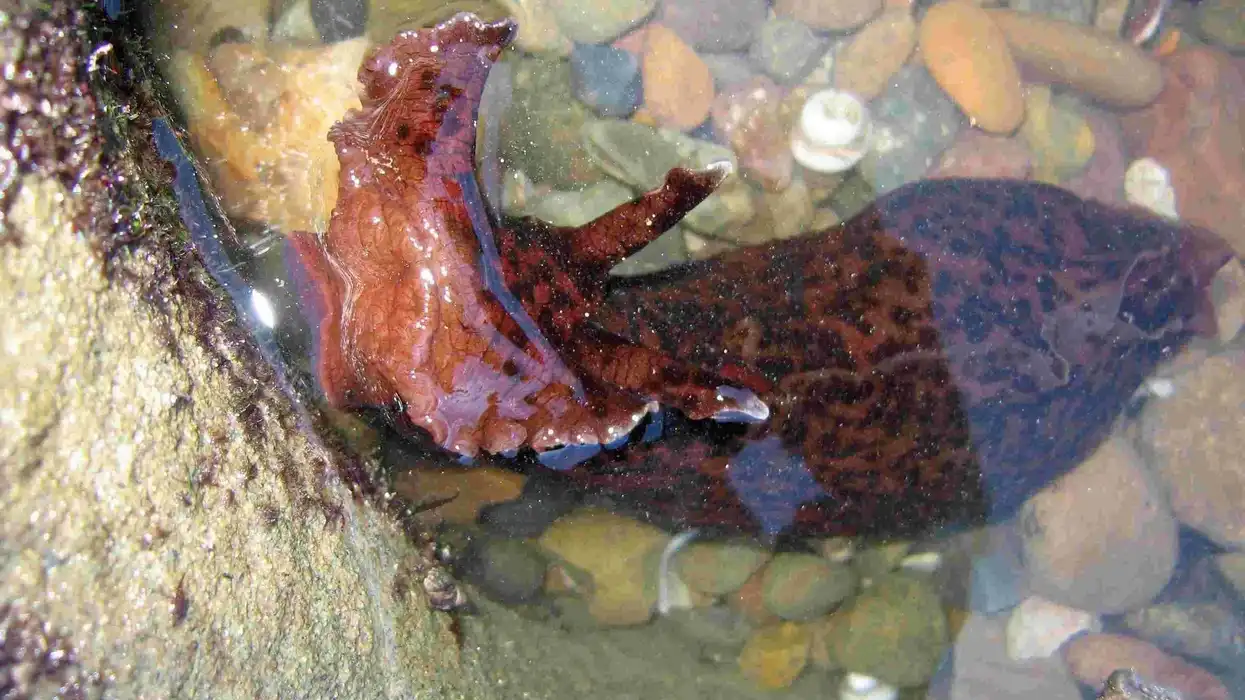Fun Florida Softshell Turtle Facts For Kids
Florida Softshell Turtles, scientifically known as Apalone ferox belong to the family Trionychidae and genus Reptilia. The word 'ferox' means ferocious.
These softshells are considered ferocious because of their size and sharp claws. These softshells belong to one of the 26 species of softshells. They are native to the southern or more specifically southeastern United States.
While they are mostly found in lakes, other areas include canals, streams, and roadside ditches. Its locations include Florida, southern Georgia, southeastern South Carolina, and also Alabama.
These are large turtles that have a long snorkel-like nose that helps in breathing underwater, elongated necks, and a flattened pancake-looking body. The carapace is bumpy and is covered with leathery skin along with longitudinal rows of tubercles with white skin underneath.
These turtles also have webbed feet with claws which helps them to move them on land as well as water. The adults are dark brown or brownish-gray in color with a yellowish pattern.
These turtles are highly aquatic and thus are powerful swimmers but can also move on land properly. When on land they tend to be in burrows of sand near the water and even in water they tend to bury themselves in the sandy substrates.
These turtles are carnivorous and eat fish, mollusks, snails, aquatic birds like ducks and other amphibians and crustaceans.
They can also seek to scavenge. While these species seem engaging, they are highly wild.
Read on for more facts about the Florida Softshell Turtle (Apalone ferox). If you enjoy this article, check out Olive Ridley sea turtle and snapping turtle facts after.
Florida Softshell Turtle Interesting Facts
What type of animal is a Florida Softshell Turtle?
A Florida Softshell Turtle belongs to the category of turtles.
What class of animal does a Florida Softshell Turtle belong to?
Florida Softshell Turtle belongs to the class of reptiles.
How many Florida Softshell Turtles are there in the world?
There has been no exact number recorded for these softshell turtles due to difficulties like long-term marking and capture.
Where does a Florida Softshell Turtle live?
These softshell turtles are native to the Southeastern United States and found in freshwaters ranging in Florida, southern Georgia, and southeastern Carolina.
What is a Florida Softshell Turtle's habitat?
These softshell turtles are highly aquatic and found in freshwaters. They are mostly found in lakes, streams, canals, and roadside ditches. They can also be found in water bodies with sandy or muddy bottoms and also in brackish waters. These turtles prefer slow-moving or almost still water.
Who do Florida Softshell Turtles live with?
It is believed that these softshell turtles live on their own and when in water, it prefers to stay buried in the sandy substrates.
How long does a Florida Softshell Turtle live?
The average and maximum lifespan of these softshell turtles is unknown but certain species have been reported to live for 20 years and more.
How do they reproduce?
This softshell turtle is polygynandrous. Spring is the mating season and during the fall, the sperms of the male turtle are stored by them, and then the stored sperm can be utilized during copulation in the Florida Softshell Turtle season for mating.
The male softshell turtle reaches sexual maturity at small sizes and thus, certain male turtles can reproduce at the age of two years. Females achieve sexual maturity at bigger sizes with much more variability, thus, at the age of five to eight years.
The female nesting season ranges from April-August and the incubation period lasts for 50-90 days.
Females have the ability to produce four to five eggs in clutches in one breeding season. Florida Softshell Turtle eggs are laid near water in soft and sandy areas.
To come out, hatchlings crack the shells with their sharp claws and egg tooth. The young ones fully develop at birth and are able to live on their own.
What is their conservation status?
The conservation status of these softshell turtles is Least Concern and in many states where different turtle species live, they are not protected.
Florida Softshell Turtle Fun Facts
What do Florida Softshell Turtles look like?
These turtles are known to be large and shaped like a pancake as they have flattened backs and bodies. They have long necks, elongated heads, and a long nose that looks like a snorkel. These softshell turtles have webbed feet with claws.
The color pattern on their bodies is known as countershading which helps in camouflaging and hiding from predators. These softshell turtles are known to be the bulkiest.
Adults are dark brown or brownish-gray in color with bumpy and leathery skin carapace. These turtles lack scutes and a hard shell. The carapace of these turtles is covered with longitudinal rows of tubercles which is less evident in larger turtles.

How cute are they?
These softshell tutles are not considered cute rather they are known to be large, bulky, and sometimes weird-looking turtles.
How do they communicate?
While not much is known about the communication of these softshell turtles, it is believed that the orientation of these turtles is based on solar (sun) cues with internal time sense. These turtles also produce a repugnant smelling musk or excretion to warn off predators.
How big is a Florida Softshell Turtle?
These softshell turtles are known as one of the bulkiest turtles, the adult females are three to five times larger and heavier than the males. The weigh range of these turtles is 5.9-14.7 lb (2.7-6.6 kg).
The average weight of male adult turtles is 5.9 lb and that of females is 14.7 lb. The length ranges from 6-24 in (152-609 mm). Thus, this species is the largest species found in Florida and all of North America.
How fast can a Florida Softshell Turtle move?
While these turtles are highly aquatic, they are known to move fast on land and water both and can be faster when feeling threatened.
How much does a Florida Softshell Turtle weigh?
The weight of this softshell turtle varies among males and females, the females are known to be larger and heavier than the males. The weight ranges from 5.9-14.7 lb (2.7-6.6 kg), the average weight of male adult turtles is 5.9 lb and that of females is 14.7 lb.
What are their male and female names of the species?
There are no specific names for males and females of this turtle species.
What would you call a baby Florida Softshell Turtle?
There is no specific name for a baby Florida Softshell Turtle.
What do they eat?
These softshell turtles are known to be carnivores and eat fish, snails, insects, crustaceans, and amphibians which includes frogs, mollusks, small turtles. They also prey on waterfowl animals like ducks and even small herons.
Are they poisonous?
While these softshell turtles are not poisonous, they could be highly aggressive. You will need to watch out for the Florida Softshell Turtle bite and their powerful and sharp claws could injure or cause damage.
Would they make a good pet?
While people become highly interested in keeping turtles as pets, this species of softshell turtles require high and expensive maintenance and Florida Softshell Turtle care is a delicate matter. These turtles could be taken care of by experienced turtle owners.
These softshell turtles could make a good pet when taken care of well but would require a lot of effort on the owner's part and so, a spiny softshell is preferred over these softshell turtles.
Did you know...
The Apalone ferox is the largest species of softshells in Florida and North America.
This species of softshells live for 20 years and can live more than 30 years in captivity.
While they have a carnivorous diet, they also prey on algae and aquatic plants and can scavenge and hunt apart from amphibians and crustaceans. This species of the reptiles class do not possess teeth yet can harm with its sharp claws and jaws and bite.
The species Apalone ferox is sexually dimorphic and the size of females exceeds the size of the largest males by at least three times. These turtles are willing to travel long distances to seek better conditions and can tolerate high temperatures.
They are active all year in mild temperatures and are inactive during cold weather. They also tend to hibernate during the coldest part.
The white-colored underside body of the carapace tends to visually hide the young ones from potential predators. Their predators include alligators, American Black bears, fish crows, foxes, skunks, and raccoons. These turtles are popular for their meat but are also kept as a pet. If kept as a pet, UVB lighting is required to keep them warm.
Humans and their activities are major threats to this animal which includes habitat destruction, pollution, overharvest, and vehicle strikes.
They resemble the spiny softshells but can be distinguished by their habitat and range while the Florida softshells are found in coastal plains and are found in ponds and wetlands, the other prefers rivers and streams.
Some people find this turtle weird and gross-looking when in a basking or resting position.
How to tell if my Florida Softshell Turtle is a male or female?
It is quite easy to identify between a male and female Florida Softshell Turtle. There exist certain differences among the male and female of this turtle species. The first being the size of both the sexes.
The females tend to be larger than the males. The females are longer and heavier than the males.
The second identifiable or recognizable difference is in the tail of this species. While female turtles tend to be longer and heavier, their tails are comparatively shorter and do not go beyond the edge of their upper shell. On the other hand, the males have lengthy and wide tails which go beyond the edge of their upper shell.
How to care for Florida Softshell Turtles
This species of the softshell turtle requires a great deal of care. Firstly, is the Florida Softshell Turtle diet.
As these turtles are carnivores, they eat snails, fish, insects, frogs, and crustaceans, so you can feed your pet small fish like mosquitofish and a commercial pellet diet to ensure all the nutrients are provided. It should also be noted that these turtles enjoy some live food so it should be provided too.
Secondly, the environment and habitat should be highly taken care of. This softshell turtle requires huge space and an adult Florida Softshell Turtle might require a 200-gallon tank which would require huge space too. You could also provide your turtle a safe underwater hiding spot as these turtles like to be buried in sandy substrates when in water.
The air temperature should be maintained between 75-85 degrees Fahrenheit and the basking area should be warmer around 90 degrees Fahrenheit. The water temperature should be between 70-80 degrees Fahrenheit with the help of a good quality water heater.
To ensure the health of your turtle, it should be ensured that it is provided filtered fresh water at all times. You should also ensure that there is a sand substrate instead of a rock one which could harm the sensitive body of this turtle. It should also be deep enough for the turtle to burrow.
While the softshell turtle will bask only occasionally, it should be checked that the natural or artificial basking platform is in a stable position and at an appropriate angle to allow the turtle to bask easily. To provide a good basking area, sandstone, and concrete rocks should be avoided as it irritates the plastron.
It is advised that this softshell turtle should be kept alone as it could be aggressive and injure the other turtle. Even when handling the turtle, it should be done with proper care as it could harm you with its large and sharp claws and thus, should be handled only when required or necessary.
Here at Kidadl, we have carefully created lots of interesting family-friendly animal facts for everyone to discover! Learn more about some other reptiles including bog turtle, or Aldabra giant tortoise.
You can even occupy yourself at home by drawing one on our Florida Softshell Turtle coloring pages.
We Want Your Photos!
More for You
Bachelor of Arts specializing in English Literature

Akinwalere OlaleyeBachelor of Arts specializing in English Literature
As a highly motivated, detail-oriented, and energetic individual, Olaleye's expertise lies in administrative and management operations. With extensive knowledge as an Editor and Communications Analyst, Olaleye excels in editing, writing, and media relations. Her commitment to upholding professional ethics and driving organizational growth sets her apart. She has a bachelor's degree in English Literature from the University of Benin, Edo State.
Disclaimer
1) Kidadl is independent and to make our service free to you the reader we are supported by advertising. We hope you love our recommendations for products and services! What we suggest is selected independently by the Kidadl team. If you purchase using the Buy Now button we may earn a small commission. This does not influence our choices. Prices are correct and items are available at the time the article was published but we cannot guarantee that on the time of reading. Please note that Kidadl is a participant in the Amazon Services LLC Associates Program, an affiliate advertising program designed to provide a means for sites to earn advertising fees by advertising and linking to Amazon. We also link to other websites, but are not responsible for their content.
2) At Kidadl, we strive to recommend the very best activities and events. We will always aim to give you accurate information at the date of publication - however, information does change, so it’s important you do your own research, double-check and make the decision that is right for your family. We recognise that not all activities and ideas are appropriate for all children and families or in all circumstances. Our recommended activities are based on age but these are a guide. We recommend that these ideas are used as inspiration, that ideas are undertaken with appropriate adult supervision, and that each adult uses their own discretion and knowledge of their children to consider the safety and suitability. Kidadl cannot accept liability for the execution of these ideas, and parental supervision is advised at all times, as safety is paramount. Anyone using the information provided by Kidadl does so at their own risk and we can not accept liability if things go wrong.
3) Because we are an educational resource, we have quotes and facts about a range of historical and modern figures. We do not endorse the actions of or rhetoric of all the people included in these collections, but we think they are important for growing minds to learn about under the guidance of parents or guardians.







